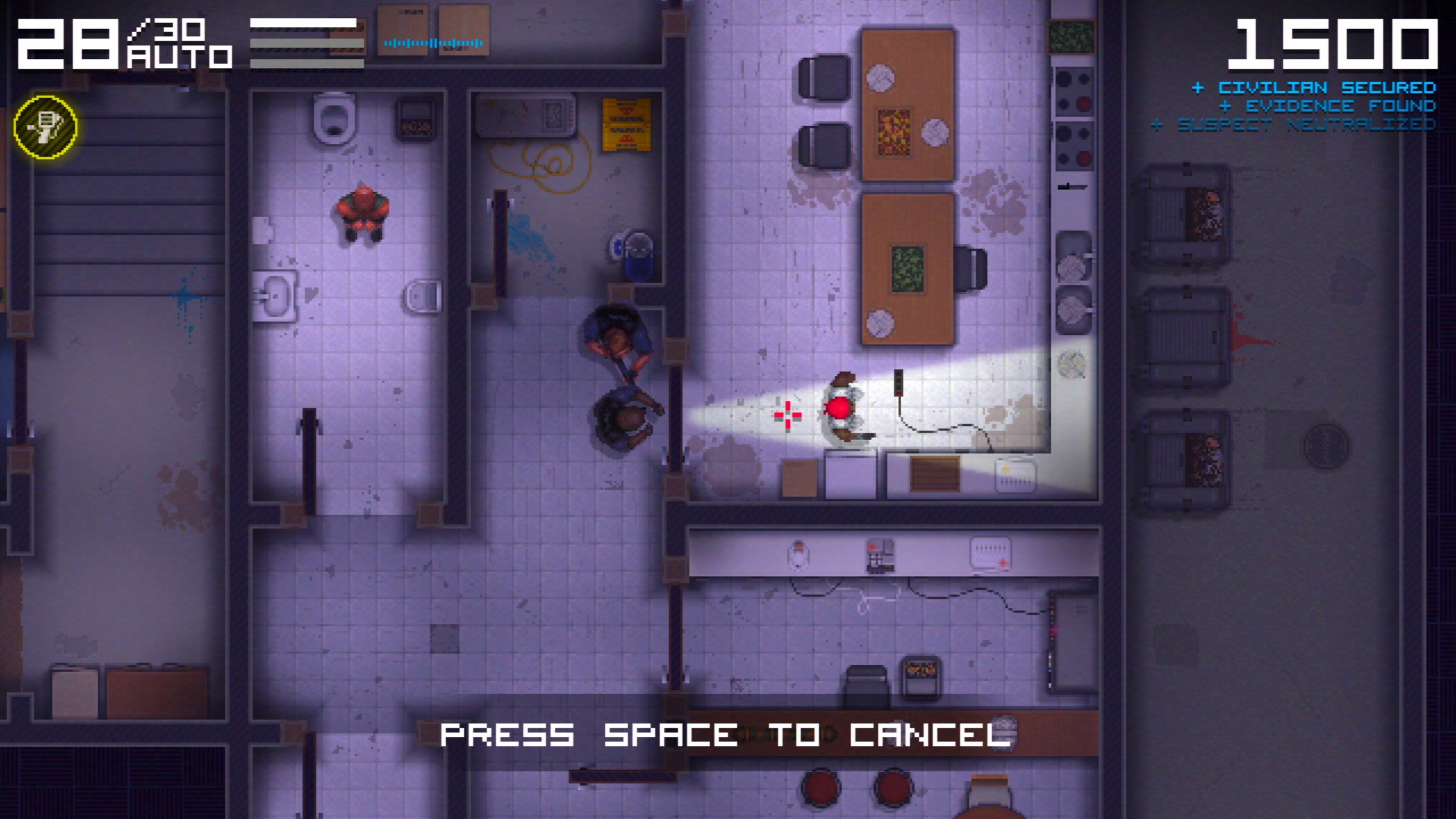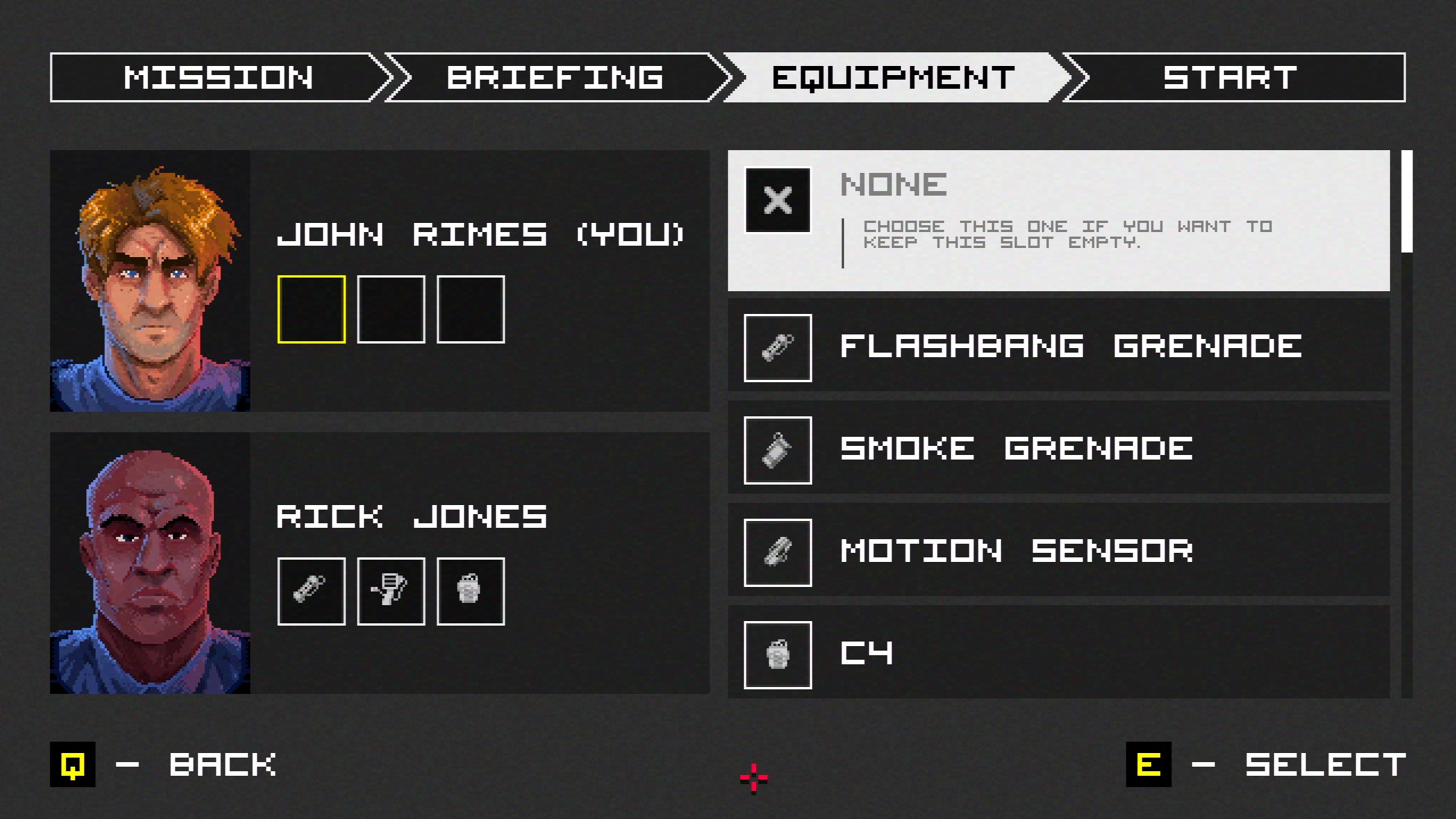A police game that asks you to think before shooting
Police Stories is tense, exciting, and ideally not so deadly.
ABOVE: Raw gameplay footage of a hospital level.
I like it when action games like Metal Gear Solid and Dishonored challenge me to minimize how much violence I dish out. One of my recent favorites, Watch Dogs 2, gives me every opportunity to tackle fun action scenarios with non-lethal melee and a stun gun. Other times, I have to be more creative or simply give up the playstyle altogether.
But with Police Stories, that constraint is the game. It’s a cop game that looks and plays like Hotline Miami but has more in common with the slower, more tactical first-person SWAT series in practice. To achieve the best score in a given level, not a single shot should be fired, nor a single body dropped. Instead, it’s about arresting suspects while utilizing a kit of police gadgets, like tactical cameras, stun grenades, pepper spray, and breaching charges.
It’s a strong concept backed up by some solid mechanics, but the preview build I played still has plenty of kinks to be sorted out.
Yes, you and your partner have guns. Yes, you may have to use them when a suspect tries to kill you. But you don’t just shoot first and ask questions later. Killing a suspect without first tapping E to shout “HANDS UP, GET ON THE GROUND” will dock you with an “unauthorized use of force” penalty. The same goes for a suspect that’s carrying a gun but has yet to raise it to you. I commanded an armed drug dealer to stand down, and they replied with “I’m not afraid,” creating a high-tension standoff. My instinct was to shoot. He wasn’t shooting at me, but he had a gun and wasn’t putting it down. Then I remembered a loading screen tooltip—something about “warning shots.”

I lit up the room with full-auto fire. Not at the guy, but into the wall right next to him. He dropped to his knees and pushed the gun away. I commanded my partner to cuff him. Finding a way to solve that scenario without bloodshed felt cool, but that’s not how it always turned out. Sometimes after multiple failed attempts I would burst into a room impatiently, see a suspect, and panic. A few times, I shot someone who was in the process of putting down their weapon, mistaking them for trying to shoot. Every time, my heart sank. The way they fell, screamed, and bled out was crushing. I expected to fail the mission. I wanted to, even. I wanted the game to tell me, “This is not OK. You’re done.” But instead, I just got a little penalty on my score.
Police in the United States killed 1,129 people in 2017, but just 12 officers were charged with a crime related to a shooting death. For how much Police Stories aims to make your actions matter, it's unfortunate that it doesn't better represent the consequences of needlessly taking a person's life. I might have gotten an “F” grading, but I still got a high score and a "mission complete."
Gearing up
Most action games like this build their depth from a variety of weapons, powerups, or whatever it may take to make its action more exciting. Police Stories pulls off that same depth by making guns a worst-case option and keeping all the real fun in the non-lethal gadgets. You can only see what’s within your line-of-sight, so the tactical camera that lets you peek under doorways is essential. If the next room had a suspect with a gun already pointed at a hostage, I knew there would be no time to detain them like normal. Instead, I commanded Rick to open the door while I immediately tossed in a stun grenade. After it exploded, I rushed in, pepper-sprayed them to the ground, and cuffed them.
The biggest gaming news, reviews and hardware deals
Keep up to date with the most important stories and the best deals, as picked by the PC Gamer team.
Little anecdotes like this are what makes Police Stories work so well. It’s a strong concept backed up by some solid mechanics, but the preview build I played still has plenty of kinks to be sorted out. The controls for commanding Rick around are a little buggy. Sometimes when asking him to use the camera on a door, he’d simply walk right in instead, often getting him or a hostage killed in the process. He can also only use his grenades on doors, even though it’s often useful to toss one around a corner or through a window. But these are pretty minor things in a game that’s shaping up really well.

The preview build I played featured four missions out of a total of 18 that are planned for launch. The objectives in the ones I played ranged from simple hostage rescue to drug busts and an eventual bomb defusal, which can be seen in the video above. The layouts of each level are set, but the placement of objectives, hostages, and suspects are random. This was definitely welcome as a way to keep a mission feeling fresh after multiple failures. There doesn’t seem to be any overall story, but each mission is introduced with a brief synopsis of the situation. A two-player online co-op mode allows a friend to take control of your partner.
Police Stories has the potential to be a cop game that handles its genre with some nuance. It's an action game that leverages the tension and finality of death and makes it the enemy. But when you do kill someone by error or otherwise, Police Stories doesn't go far enough to make you feel the consequence of that mistake.

Morgan has been writing for PC Gamer since 2018, first as a freelancer and currently as a staff writer. He has also appeared on Polygon, Kotaku, Fanbyte, and PCGamesN. Before freelancing, he spent most of high school and all of college writing at small gaming sites that didn't pay him. He's very happy to have a real job now. Morgan is a beat writer following the latest and greatest shooters and the communities that play them. He also writes general news, reviews, features, the occasional guide, and bad jokes in Slack. Twist his arm, and he'll even write about a boring strategy game. Please don't, though.

